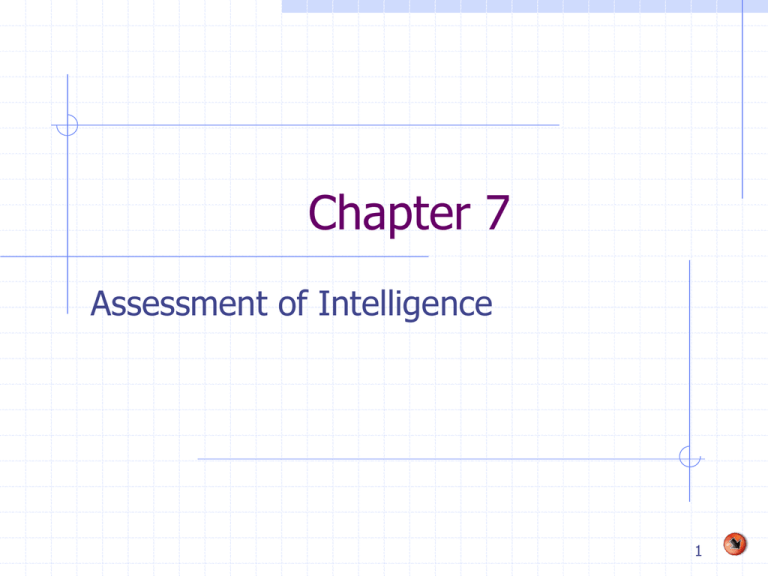Chapter 7
advertisement

Chapter 7 Assessment of Intelligence 1 Defining and Purpose of Intelligence Testing Type of aptitude test that measures a range of intellectual ability. Offers broad assessment of one’s cognitive capabilities. Some ways intelligence tests are used: Assist in determining giftedness, Assist in determining mental retardation, Assist in determining learning disabilities, To understand changes in brain function due to accidents, dementia, aging, abuse, and disease, As part of admissions process to certain private schools, and As part of personality assessment to aid in understanding the whole person. 2 Models of Intelligence Edward Spearman’s (1863-1945) twofactor approach: General factor (g) and specific factor(s). “Weight” of g varied as a function of what was being measured. E.g., ratio of general intelligence (g) to specific talent for music (s) was 1 to 4. 3 Models of Intelligence (Cont’d) Thurstone’s Multifactor Approach Seven primary mental abilities: verbal meaning, 2. number ability, 3. word fluency, 4. perception speed, 5. spatial ability, 6. reasoning, and 7. memory. 1. 4 Models of Intelligence (Cont’d) Vernon’s Hierarchal Model of Intelligence Vernon’s top level is like Spearman’s (g) Second level has: “v:ed” for verbal and educational abilities, and “k:m” which represents mechanical-spatial-practical abilities. Third level is comprised of minor group factors. Fourth level is made of specific factors. See Figure 7.1, p. 131 5 Models of Intelligence (Cont’d) Guilford’s Multifactor/Multi-dimensional Model Three-dimensional model of cognitive ability: operations, or the processes we use in understanding, 2. contents, or what we use to perform our thinking process, and 3. product, or the end result of our thinking processes. 1. See Figure 7.2, p. 132 6 Models of Intelligence (Cont’d) Cattell’s Fluid and Crystal Intelligence Fluid gf intelligence: The culturally free portion of intelligence with which we are innately born. Crystallized intelligence (gc): Acquired as we learn, and affected by our experiences, schooling, culture, and motivation. Crystallized intelligence generally increase with age and fluid intelligence tends to slightly decline as we age. See Figure 7.3, p. 133 7 Models of Intelligence (Cont’d) Piaget’s Cognitive Development Theory Developmental model. Speaks to how one learns, not amount of learning. Stages: sensorimotor, preoperational, concrete operational, and formal operational. Two major concepts: 1. 2. Assimilation: incorporating new stimuli or information into existing cognitive structures. Accommodation: creating new cognitive structures and/or behaviors from new stimuli. 8 Models of Intelligence (Cont’d) Gardner’s Theory of Multiple Intelligences Nine identified intelligences: 1. 2. 3. 4. 5. Verbal-Linguistic Mathematical-Logical Musical Visual-Spatial Bodily-Kinesthetic 6. Interpersonal Intelligence 7. Intrapersonal Intelligence 8. Naturalist 9. Existential Intelligence (not yet confirmed) Says all humans have different amounts of these. Based on research of brain-damaged, literature, evolution, genetics, psychology and anthropology. Theory is revolutionary, not mainstream. 9 Intelligence Testing To some degree, theories of intelligence are the basis for intelligence tests. Traditional intelligence tests measure intelligence based on traditional constructs (e.g., “g” and “s”) as opposed to Gardner’s model. Most prominent intelligence tests: Stanford-Binet The three Wechsler Scales of Intelligence 10 Stanford Binet Intelligence Test Dates back to original work of Binet in 1904. Takes 45 to 60 minutes. Ages 2 to 90+ year olds. Uses routing test, to help determine basal age. Then uses ceiling age. Measures verbal and nonverbal intelligence across five factors: fluid reasoning, knowledge, quantitative reasoning, visualspatial processing, and working memory. 11 Stanford-Binet (Cont’d) Discrepancies between verbal and nonverbal scores can be an indication of a learning disability (See Table 7.2, p. 138). Reliability: For Full-Scale IQ = .97=.98. Correlates highly with other intelligence tests, Uses SD of 15, M = 100. See Profile Sheet, Fig. 7.4., p. 139 12 Wecshler Scales of Intelligence WAIS-III (Wechsler Adult Intelligence Scale) 16–89 yrs. WISC-IV (Wechsler Intelligence Scale for Children) 6– 16yrs. WPPSI-III (Wechsler Preschool and Primary Scale of Intelligence), 2.5 - 7yrs. and 3 months. Similar tests: Downward extensions of each other. Useful in assessing general cognitive functioning, mental retardation, giftedness, and learning problems 13 The WISC-IV (as a general example of all Wechsler Tests) Contains 15 subtests (see Table 7.3, p. 141) The 15 subtests provide a Full Scale IQ and four composite score indexes (see Table 7.4, p. 142): 1. Verbal Comprehension Index (VCI), 2. Perceptual Reasoning Index (PRI) 3. Working Memory Index (WMI), and 4. Processing Speed Index (PSI). Uses Mean of 100, SD of 15 for FSIQ. Uses Mean of 10, SD of 3 for subscales. See Profile: Fig. 7.5., p. 143 14 Kaufman Assessment Battery for Children Individually administered test of cognitive ability for ages 3 to 18. Subtests and scoring allows for a choice between Cattell’s model of fluid and crystallized intelligence. Examines visual processing, fluid reasoning, and short-term and long-term memory. Uses Mean of 100, SD of 15 Good reliability and validity. 15 The Role of Helpers in the Assessment of Intelligence The assessment of intelligence takes advanced training. Many graduate programs do not automatically offer this training. Can get training on your own after or during your grad degree. Imperative that you have the basic knowledge of intelligence tests so you know when to refer and to participate in the development of treatment plans. 16 Final Thoughts on Intelligence Testing Abuse of intelligence testing has occurred: Used to maintain status quo (e.g., brighter people are better than those who have musical ability). Miscalculation intelligence of minorities. Over-classification of individuals who are learning disabled. Misguided tool to defend racial differences of ability Means to differentiate social classes. 17 Final Thoughts on Intelligence Testing (Cont’d) Assessment of intelligence is complex and based on a number of factors: environment, genetics, and biology. Conclusions should be done knowing the “whole person” as well as the societal issues that are involved. All conclusions re: intelligence should have some degree of tentativeness to it. 18



